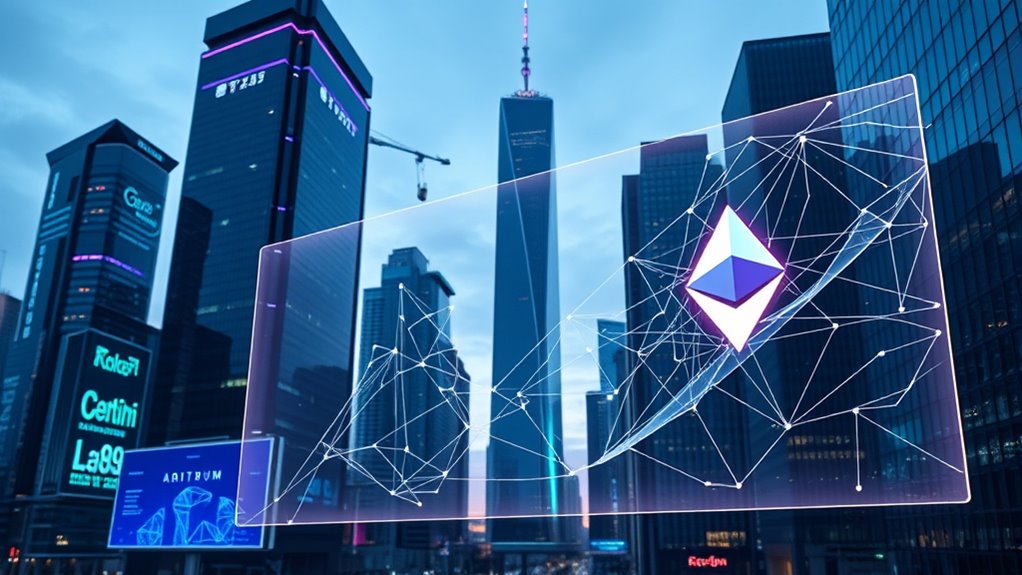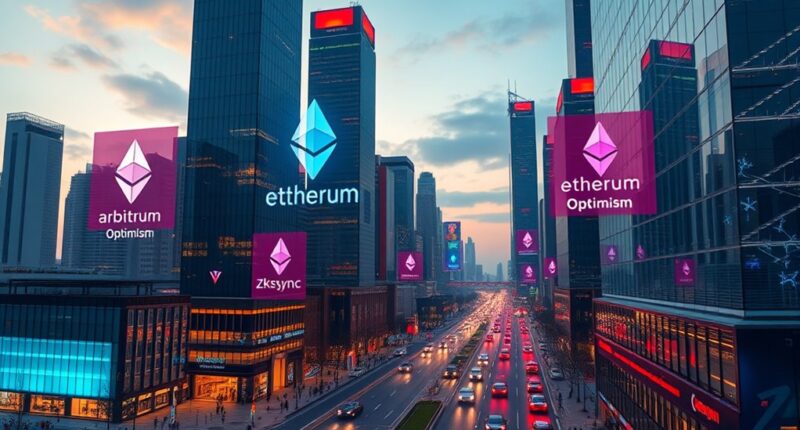By 2025, Ethereum’s Layer-2 solutions like Arbitrum, Optimism, and ZkSync have markedly boosted the network’s scalability and user experience. You’ll find faster, cheaper transactions with less congestion, making crypto more accessible. Arbitrum leads with high adoption, while Optimism focuses on seamless DeFi integration. ZkSync emphasizes security and privacy, appealing to sensitive users. If you keep exploring, you’ll discover how these advancements continue to shape Ethereum’s future.
Key Takeaways
- Ethereum Layer-2 solutions like Arbitrum, Optimism, and ZkSync dominate transaction processing with high adoption and enhanced scalability.
- Arbitrum leads in optimistic rollups, offering fast, low-cost, and developer-friendly experiences.
- Optimism focuses on seamless DeFi and NFT integrations, ensuring broad ecosystem compatibility.
- ZkSync emphasizes security and privacy with zero-knowledge rollups, appealing to privacy-conscious users.
- The Layer-2 ecosystem in 2025 drives Ethereum’s daily usability, reducing congestion and gas fees significantly.

By 2025, Ethereum’s Layer-2 solutions have become integral to the network’s scalability and user experience. You notice that transactions on the main Ethereum chain are now faster, cheaper, and more reliable, thanks to these solutions. As a user, you find that Layer-2 protocols like Arbitrum, Optimism, and ZkSync deliver significant scalability improvements. These solutions process most transactions off the main chain, reducing congestion and gas fees, making Ethereum more accessible for everyday use. This shift has driven a surge in user adoption, as newcomers and seasoned users alike prefer Layer-2 platforms for their efficiency and cost-effectiveness.
By 2025, Layer-2 solutions make Ethereum faster, cheaper, and more accessible for everyday transactions.
You see that Arbitrum has established itself as a leader in optimistic rollups, offering near-instant transaction finality with minimal fees. Its usability has improved dramatically, thanks to streamlined onboarding processes and developer-friendly tools. This encourages more dApps to deploy on Arbitrum, further expanding its ecosystem. Optimism, similarly, has focused on enhancing its scalability through optimistic rollups, providing a seamless experience for DeFi projects and NFT platforms. The platform’s compatibility with existing Ethereum infrastructure makes it easier for developers to migrate or build new applications, boosting user adoption.
Meanwhile, ZkSync has gained ground with its zero-knowledge rollup architecture, emphasizing security and privacy while maintaining high throughput. Its scalability improvements allow for quick settlements and low-cost transactions, which appeals to both users and developers prioritizing privacy features. As users become more aware of these advantages, ZkSync’s adoption grows, especially among those concerned about data security. The interoperability features across these Layer-2 solutions mean you can move assets swiftly and securely between platforms, enhancing your overall experience and confidence in using Ethereum-based services.
All these advancements have created a more vibrant and competitive Layer-2 landscape. You notice that the ecosystem’s growth is driven by continuous innovation, which makes Ethereum more scalable and user-friendly than ever before. The combined effect of scalability improvements and increased user adoption has transformed Ethereum into a more practical platform for daily transactions, decentralized finance, gaming, and beyond. With Layer-2 solutions now deeply integrated, you have a smoother, more affordable experience, reinforcing Ethereum’s position as the leading blockchain network in 2025. Additionally, the development of high refresh rates and low input lag in blockchain scaling solutions enhances transaction responsiveness, further improving usability for real-time applications.
Frequently Asked Questions
How Do Layer-2 Solutions Impact Ethereum’s Long-Term Scalability?
Layer-2 solutions boost Ethereum’s long-term scalability by enabling scalability breakthroughs that reduce network congestion and transaction fees. You’ll notice faster processing and lower costs, making the network more practical for everyday use. However, you might face decentralization tradeoffs, as some solutions rely on fewer validators or operators. Overall, these solutions help Ethereum grow sustainably, balancing scalability with decentralization to support widespread adoption.
What Are the Main Security Trade-Offs of Different Layer-2 Protocols?
You need to contemplate that different Layer-2 protocols balance security trade-offs like fraud prevention and censorship resistance differently. Rollups like Optimism and Arbitrum rely on fraud proofs, which can be vulnerable to delayed fraud detection. Zksync uses zero-knowledge proofs, offering strong fraud prevention but may face complexity in censorship resistance. Your choice impacts how well your transactions are protected against malicious attacks and censorship attempts.
How Do Layer-2s Influence User Experience and Transaction Costs?
Imagine Layer-2s as bridges over a busy river, making your journey smoother. They substantially improve user experience by reducing transaction times and making interactions more seamless. Plus, they cut transaction costs, saving you money and encouraging more activity. With these bridges, you move faster and spend less, turning complex blockchain processes into simple, efficient transactions, so your experience feels more like using a trusted, fast network than dealing with congested main chains.
What Regulatory Challenges Do Layer-2 Solutions Face in 2025?
In 2025, you’ll face regulatory challenges with Layer-2 solutions like ensuring compliance with evolving rules around financial transparency and anti-money laundering. Privacy concerns also come into play, as authorities seek to balance user confidentiality with regulatory oversight. You need to stay adaptable, implement robust compliance measures, and address privacy issues proactively to navigate potential legal hurdles while maintaining the benefits of Layer-2 scalability.
How Do Layer-2s Collaborate With Ethereum’s Mainnet for Interoperability?
You leverage cross chain bridges and interoperability standards to connect Layer-2 solutions with Ethereum’s mainnet. These bridges enable seamless asset transfers and data sharing, ensuring interoperability. Layer-2s like Arbitrum, Optimism, and Zksync adopt these standards to maintain security and efficiency. By integrating these tools, you facilitate smooth communication between the mainnet and Layer-2s, enhancing scalability and user experience across the Ethereum ecosystem.
Conclusion
By 2025, Ethereum’s Layer-2 solutions like Arbitrum, Optimism, and zkSync have matured, offering faster, cheaper, and more scalable transactions. You might wonder if these Layer-2s can truly handle mainstream adoption, but their ongoing innovation and security focus suggest they’re ready for it. Embrace these platforms—they’re not just upgrades, but the foundation for Ethereum’s future, proving that scalability and decentralization can go hand-in-hand.









